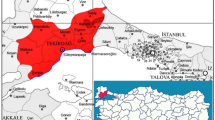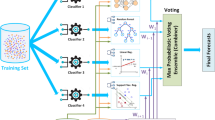Abstract
The forecasting of air pollution is important for living environment and public health. The prediction of SO2 (sulfur dioxide), which is one of the indicators of air pollution, is a significant part of steps to be done in order to decrease the air pollution. In this study, a novel feature scaling method called neighbor-based feature scaling (NBFS) has been proposed and combined with artificial neural network (ANN) and adaptive network–based fuzzy inference system (ANFIS) prediction algorithms in order to predict the SO2 concentration value is from air quality metrics belonging to Konya province in Turkey. This work consists of two stages. In the first stage, SO2 concentration dataset has been scaled using neighbor-based feature scaling. In the second stage, ANN and ANFIS prediction algorithms have been used to forecast the SO2 value of scaled SO2 concentration dataset. SO2 concentration dataset was obtained from Air Quality Statistics database of Turkish Statistical Institute. To constitute dataset, the mean values belonging to seasons of winter period have been used with the aim of watching the air pollution changes between dates of December, 1, 2003 and December, 30, 2005. In order to evaluate the performance of the proposed method, the performance measures including mean absolute error (MAE), mean square error (MSE), root mean square error (RMSE), and IA (Index of Agreement) values have been used. After NBFS method applied to SO2 concentration dataset, the obtained RMSE and IA values are 83.87–0.27 (IA) and 93–0.33 (IA) using ANN and ANFIS, respectively. Without NBFS, the obtained RMSE and IA values are 85.31–0.25 (IA) and 117.71–0.29 (IA) using ANN and ANFIS, respectively. The obtained results have demonstrated that the proposed feature scaling method has been obtained very promising results in the prediction of SO2 concentration values.










Similar content being viewed by others
References
Bridgman HA, Davies TD, Jickells T, Hunova J, Tovey K, Bridges K, Surapipith V (2002) Air pollution in the Krusne Hory region, Czech Republic during the 1990s. Atmos Environ 36:3375–3389
Afroz R, Hassan MN, Ibrahim NA (2003) Review of air pollution and health impacts in Malaysia. Environ Res 92:71–77
Aydın ME, Durduran SS, Özcan S, Bedük F (2007) Konya’da Hava Kalitesi Değişiminin Coğrafi Bilgi Sistemi (CBS) İle Değerlendirilmesi, 7. Ulusal Çevre Mühendisliği Kongresi, Yaşam Çevre Teknoloji, 831–838, 24–27 Ekim 2007, İzmir
Elbir T, Müezzinoğlu A, Bayram A (2000) Evaluation of some air pollution indicators in Turkey. Environ Int 26:5–10
Müezzinoğlu A (1987) Hava Kirliliğinin ve Kontrolünün Esasları, Dokuz Eylül Üniversitesi Yayınları, İzmir, pp 165–167
Abdul-Wahab SA, Al-Alawi SM (2008) Prediction of sulfur dioxide (SO2) concentration levels from the mina Al-Fahal refinery in Oman using artificial neural networks. Am J Environ Sci 4(5):473–481
Grivas G, Chaloulakou A (2006) Artificial neural network models for prediction of PM10 hourly concentrations, in the Greater Area of Athens, Greece. Atmos Environ 40(7):1216–1229
Wei-Zhen Lu, Hong-Di He, Li-yun Dong (2011) Performance assessment of air quality monitoring networks using principal component analysis and cluster analysis. Build Environ 46(3):577–583
Kurt A, Oktay AB (2010) Forecasting air pollutant indicator levels with geographic models 3 days in advance using neural networks. Expert Syst Appl 37:7986–7992
Akkoyunlu A, Yetilmezsoy K, Erturk F, Oztemel E (2010) A neural network-based approach for the prediction of urban SO2 concentrations in the Istanbul metropolitan area. Int J Environ Pollut 40(4):301
Kurt A, Gulbagci B, Karaca F, Alagha O (2008) An online air pollution forecasting system using neural networks. Environ Int 34:592–598
http://www.wunderground.com/history/airport/LTAN/2006/5/23/DailyHistory.html?req_city=NA&req_state=NA&req_statename=NA (Last Accessed: 2011)
Riedmiller M (1993) In: Proceedings of the IEEE international conference on neural networks (ICNN), San Francisco, pp 586–591
Riedmiller M (1994) Rprop—description and implementation details, technical report
Polat K, Güneş S (2006) A hybrid medical decision making system based on principles component analysis, k-NN based weighted pre-processing and adaptive neuro-fuzzy inference system. Digit Signal Process 16(6):913–921
Akdemir B, Kara S, Polat K, Güven A, Güneş A (2008) Ensemble adaptive network-based fuzzy inference system with weighted arithmetical mean and application to diagnosis of optic nerve disease from visual-evoked potential signals. Artif Intell Med 43(2):141–149
Jang J-SR (1991) Fuzzy modeling using generalized neural networks and kalman filter algorithm. In: Proc. of the ninth national conf. on artificial intelligence (AAAI-91), pp 762–767
Jang J-SR (1993) ANFIS: adaptive-network-based fuzzy inference systems. IEEE Trans Syst Man Cybern 23(3):665–685
http://www.ipredict.it/ErrorStatistics.aspx. Last Accessed: 2011
Yildirim Y, Bayramoglu M (2006) Adaptive neuro-fuzzy based modelling for prediction of air pollution daily levels in city of Zonguldak. Chemosphere 63:1575–1582
Acknowledgments
I would like to thank the Dr. S. Savaş Durduran for providing the SO2 dataset and valuable comments in introducing of my paper.
Author information
Authors and Affiliations
Corresponding author
Rights and permissions
About this article
Cite this article
Polat, K. A novel data preprocessing method to estimate the air pollution (SO2): neighbor-based feature scaling (NBFS). Neural Comput & Applic 21, 1987–1994 (2012). https://doi.org/10.1007/s00521-011-0602-x
Received:
Accepted:
Published:
Issue Date:
DOI: https://doi.org/10.1007/s00521-011-0602-x




